Solana's Decline and the Strong Rise of BSC
Written by: Frank, PANews
In the autumn of 2025, the competitive landscape of public chains is changing dramatically, with an escalating battle over users, capital, and ecosystem popularity. The once-dominant Solana faces another challenge of declining traffic, while BNB Chain has launched a strong "siphoning effect" with its robust new ecosystem and technological upgrades. Meanwhile, Ethereum's mainnet continues to grow steadily amidst the noise, and the Layer 2 track presents a complex picture of extremes.
PANews will delve into the latest data from major mainstream public chains, revealing the deep-seated motivations and future trends behind this migration of traffic.
Solana: Facing Challenges of Traffic Outflow with Multiple Data Indicators Declining
Solana has shown a downward trend in data performance over the past three months, losing its leading position in several metrics. The most notable declines are in the number of active addresses and the issuance of new tokens. As of September 24, the number of active wallets on the Solana network was 2.19 million, down 63.5% from 6 million in June. This level of data is even lower than the activity before August 2024, and this decline is not an isolated phenomenon. In terms of new token births, the current figure is around 31,000, a significant drop from the peak of over 80,000 created daily in January. This decline has also occurred recently; on September 15, the daily new token data was still around 50,000.
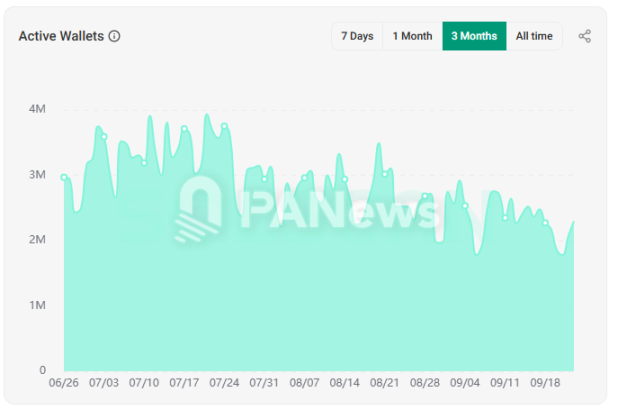
In terms of DEX trading volume, according to Dexscreene data, for the last 24 hours, the on-chain trading volume on the BSC chain was approximately $14.3 billion, while Solana's trading volume was around $8.3 billion. Solana is no longer the most active public chain in terms of trading. However, in the last 24 hours, there were still 5,919 new trading pairs created on Solana, keeping it in the top position.
In terms of capital, there has been a noticeable outflow from Solana in the past week, with a net outflow of approximately $63.4 million.
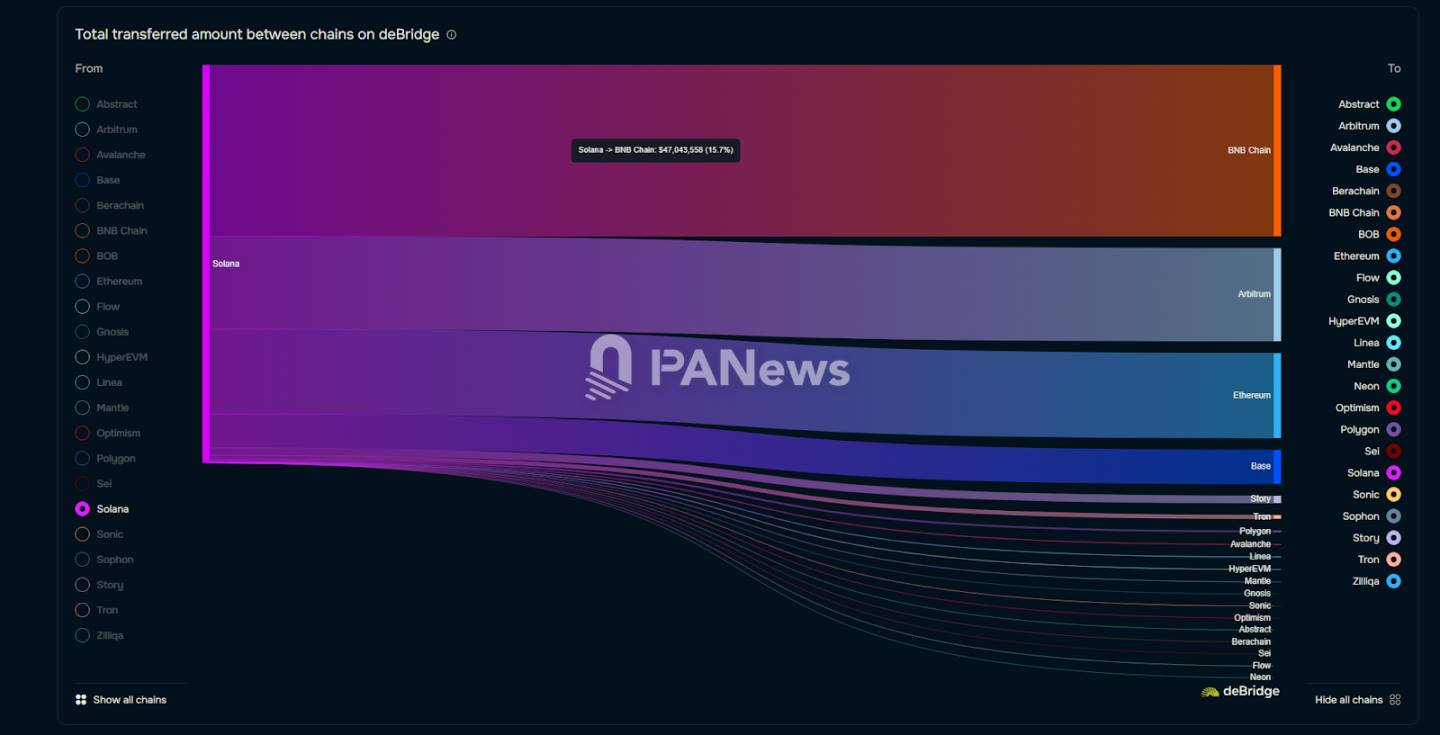
Looking at the direction of the outflow, according to deBridge data, the BSC chain has become the main destination for Solana's capital outflow, with about $47 million flowing from Solana to BSC in the past week, while only $28 million flowed back from BSC. From this perspective, BSC is indeed siphoning off Solana's traffic. Although Solana has favorable news in the capital market with ETFs and several DAT companies, and just passed the latest Alpenglow upgrade plan in September, none of these have boosted the heat of the on-chain ecosystem.
BSC: Strong Rise, Traffic Surge Aiming for Solana's Dominance
BNB Chain has been on the rise in recent months, showing signs of surpassing Solana. First, in terms of active wallet addresses, as of September 25, BSC's daily active addresses were about 4.8 million, exceeding Solana's 2.19 million. In April, this figure was only 2.6 million, an increase of about 84.6%. Additionally, there has been a significant increase in daily transaction counts, currently around 17 million per day. On August 30, this figure was only about 10 million, marking an increase of about 70% in the past month. Compared to the average of 3 million daily transactions at the beginning of the year, this represents nearly a sixfold increase.
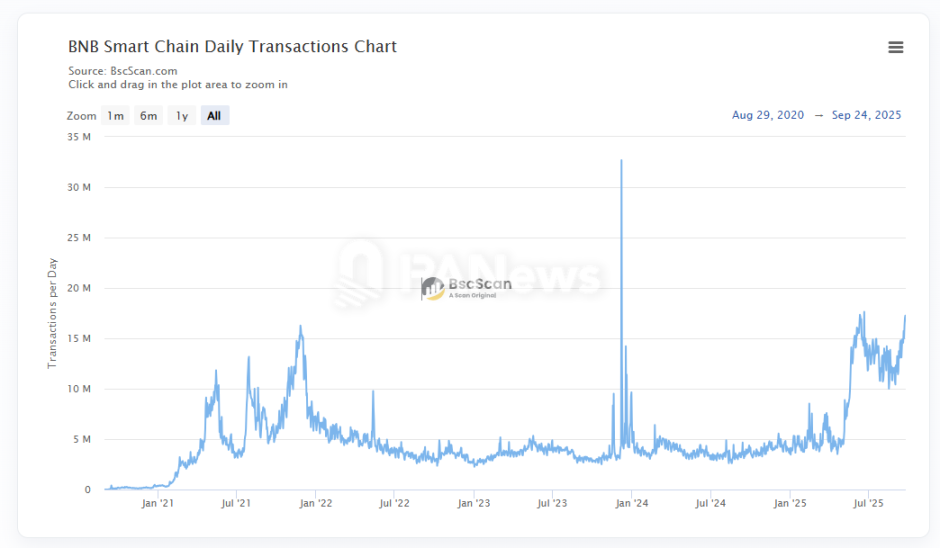
In terms of capital flow, BSC saw a net inflow of approximately $73.5 million in the past week, making it the third public chain in terms of inflow. According to deBridge data, the inflow mainly came from Solana, Arbitrum, and Ethereum's mainnet.
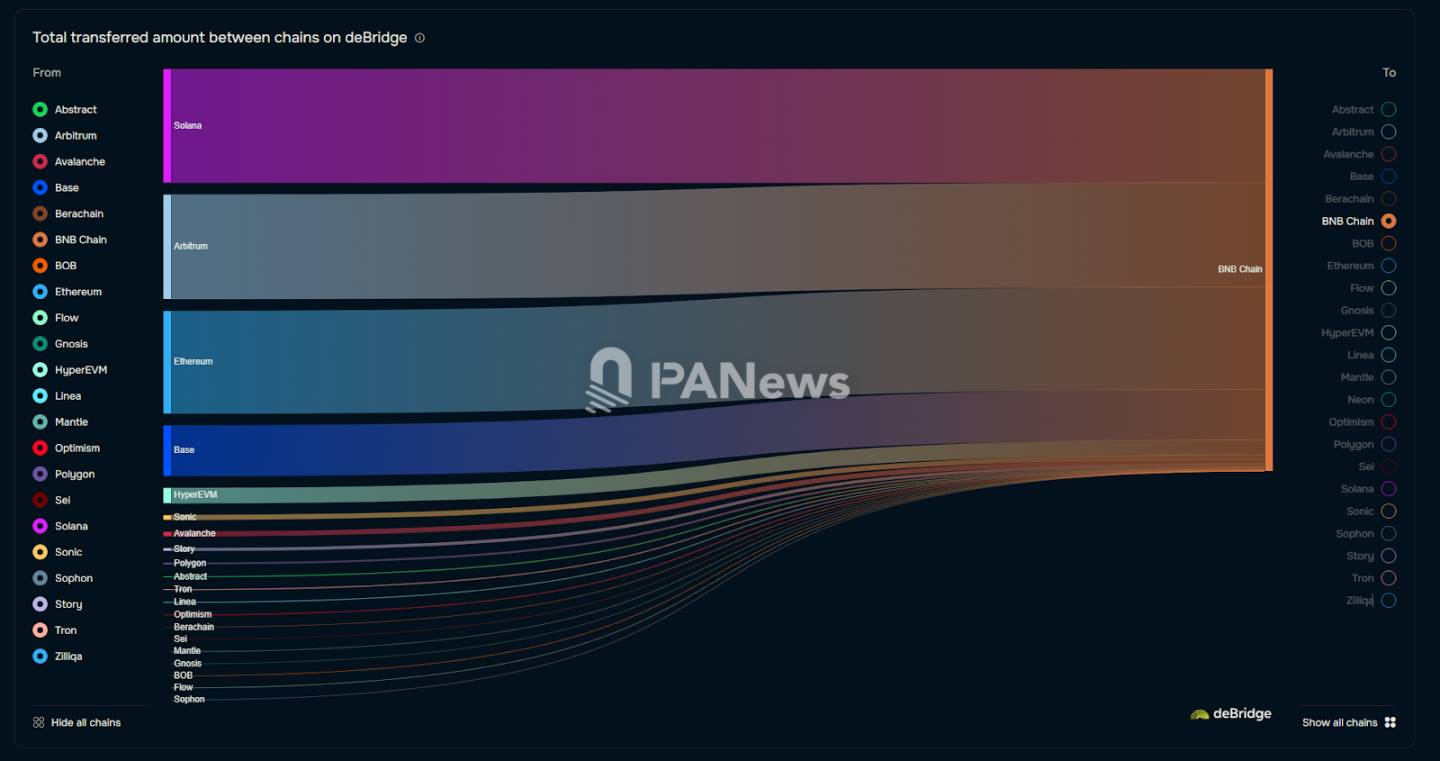
The reasons behind these changes are partly due to the wealth effect attracted by Alpha and the recent popularity of Aster. On September 25, Aster's daily fees reached an astonishing $12.92 million, second only to Tether. The contract trading volume reached $35.8 billion, surpassing Hyperliquid.

On September 23, BNB Chain disclosed on the X platform that validators are proposing to lower the minimum gas price of the BNB Smart Chain from 0.1 Gwei to 0.05 Gwei, while accelerating the block interval from 750 milliseconds to 450 milliseconds to maintain competitiveness with the fastest blockchains in the cryptocurrency space. Once this upgrade is completed, BSC will be nearly on par with Solana in terms of performance. Clearly, this charge from the BSC chain towards Solana is no longer as simple as the previous meme offensive launched by Four.me.
Ethereum: Steady Growth Amidst the Noise
Although the Ethereum mainnet does not show significant dynamics on-chain at present, there has been a noticeable improvement in data. For example, in terms of daily transaction counts, throughout 2024, Ethereum's network maintained around 1 million daily transactions. After April 2025, this figure began to rise significantly, currently maintaining between 1.5 million and 1.8 million transactions, reaching the highest level in Ethereum's history.
In terms of daily active users, a similar trend is observed. In August, Ethereum's daily active users peaked at 557,200, the highest in nearly three years. Moreover, this increase is not a fleeting moment but has been sustained over a period. As of September 22, its daily active user data remained above 500,000.
Of course, as a public chain primarily focused on DeFi and infrastructure, the rise in Ethereum's mainnet popularity does not seem to be driven by new projects. For example, on September 25, the number of new trading pools created on the Ethereum mainnet was 198, with a trading volume of around $11.5 million, accounting for only 0.3% of the day's on-chain trading volume of $3.88 billion.
Another major data change for Ethereum is TVL. Since April 2025, Ethereum's TVL has soared from $45 billion to a peak of $97 billion, but the main reason behind this data may still be the rise in ETH prices. In terms of staked ETH, this figure has been continuously declining since April. This indicates that the amount of ETH staked on the Ethereum chain is decreasing, suggesting that the new TVL may come from elsewhere. This new value may stem from the growth of stablecoins; as of September 25, the market capitalization of stablecoin issuance on Ethereum reached $161.7 billion, nearly doubling from $84 billion in December last year.
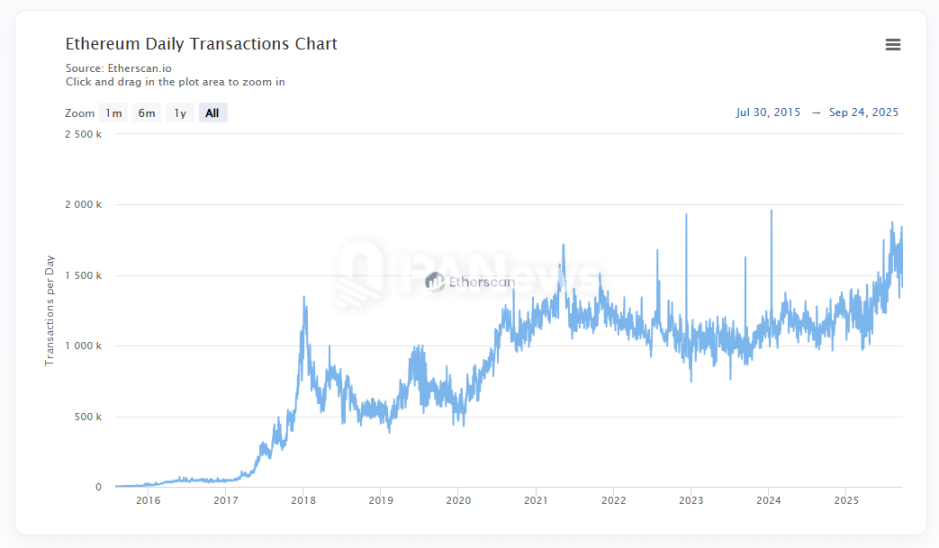
Base: Active Trading Continues, but User Loss Raises Alarm
The on-chain trading of the Base chain remains quite active. In terms of daily transaction counts, it can be seen that from around 8.4 million daily transactions in August, it grew to 14.48 million by September 21, marking a significant increase and setting a historical high, surpassing the peak data from January this year. Additionally, the number of new tokens created also shows activity, with Dexscreene reporting 3,586 new trading pools created in the last 24 hours, even higher than the BSC chain.
However, in terms of daily active data, Base has shown a significant downward trend since July, dropping from a peak of 2.4 million daily active users to 797,000 by September 22, a decline of 67%. Furthermore, in the past week, Base's net capital outflow reached $99.6 million, making it one of the public chains with the highest net outflow.
Overall, Base remains the most active public chain among Ethereum L2s, and even though there has been a decline in daily active data, it still holds advantages in various metrics.
Arbitrum: L2 Leader Position Under Pressure
Arbitrum maintains its leading position among Ethereum L2s in terms of TVL and stablecoin data, but it has shown significant volatility in daily transaction counts. On September 22, Arbitrum's daily transaction count reached 4.28 million, while the previous day it was only 1.92 million. This large fluctuation reflects the overall high volatility in Arbitrum's trading volume over the past year.
In terms of capital inflow, Arbitrum ranks first among all public chains, with a net inflow of $217 million in the past week. Looking at the sources of inflow, USDT0 and Hyperliquid remain the major contributors, indicating that Arbitrum is still playing a significant role as a capital bridge for Hyperliquid. However, with the launch of Hyperliquid's self-built stablecoin USDH, this favorable effect may soon diminish.
Hyperliquid: Facing Intense Competitive Pressure from Emerging Rivals
From the perspective of public chains, Hyperliquid's data is not particularly striking. Although its daily active users have seen significant growth, they only number 65,200. In terms of transaction counts, the weekly data is only around 3 million. The TVL data has seen substantial growth this year, increasing from $1.9 billion in April to $6.1 billion.
From the perspective of DEX, Hyperliquid has recently faced significant competitive pressure from Aster. Since August, there has been a noticeable downward trend in trading volume, fluctuating from a range of $10 billion to $20 billion down to a range of $5 billion to $10 billion.
Sui: Growth Hits a Bottleneck, Emerging Public Chains Entering a Period of Silence?
Sui's development seems to have reached a bottleneck in 2025. The number of transactions has remained around 10 million since the beginning of 2025, with no significant increase.
Although the number of active addresses is much higher than before March 2024, it has also fluctuated between 500,000 and 1 million daily active users over the past year, showing no clear upward or downward trend. In terms of TVL data, Sui has seen a significant decline, dropping from $1.24 billion in July to $575 million. The number of new trading pools created on-chain in the last 24 hours is only 40, far below the previously active MEME phase. It seems that Sui, once a promising emerging public chain, is entering a period of silence.
Avalanche: Unprecedented Surge in On-Chain Activity, RWA May Become a Future Focus
After several years of silence, Avalanche has recently experienced an explosion of activity. The most obvious data performance is in the number of active addresses, which has surged from several hundred thousand to millions since September, even reaching a historical record of 29 million on September 22. The number of transactions has also suddenly increased to the level of 50 million.
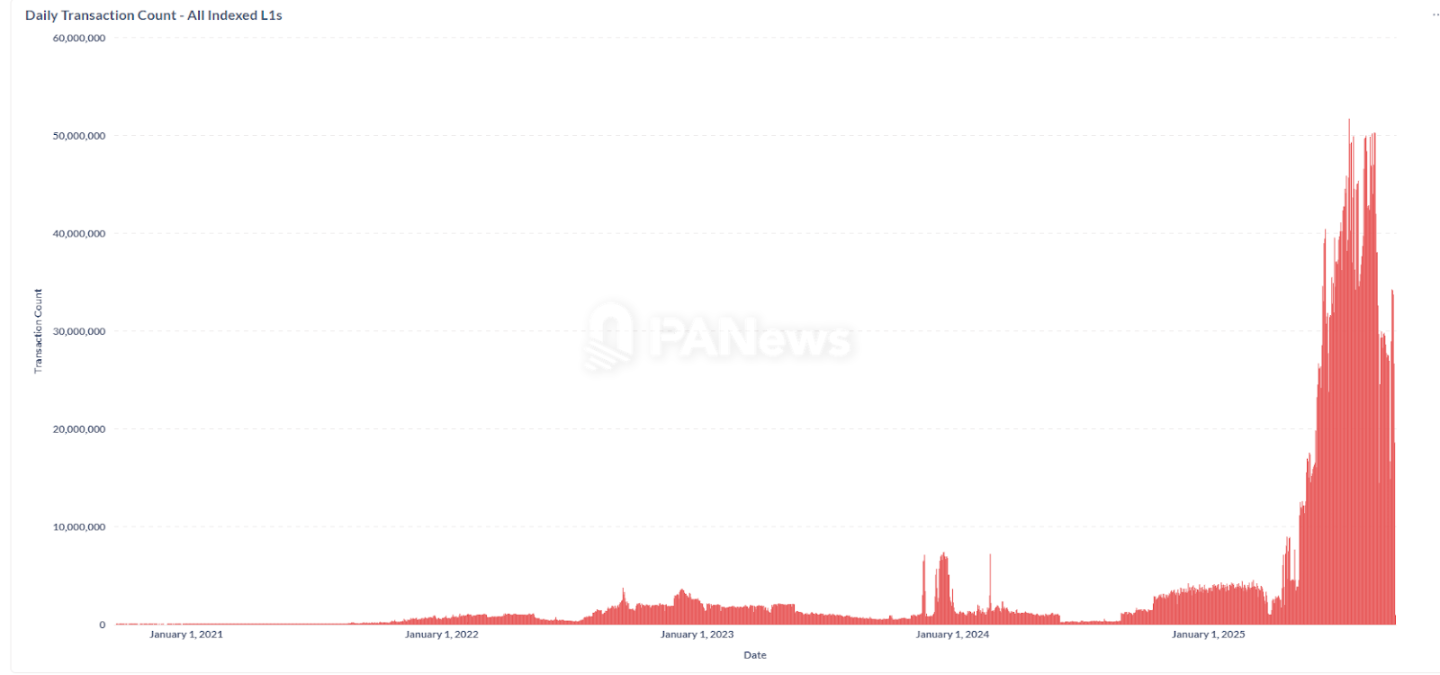
However, this surge seems to be largely unrelated to the activity of Avalanche (C-Chain). Looking solely at C-Chain's data, its number of active addresses remains around 200,000, which, although it has increased, is still significantly lower than the overall figure. PANews speculates that this abnormal increase in data may be related to a stress test conducted by a sub-network of Avalanche. In August, Grove Finance planned to allocate approximately $250 million in RWA on the Avalanche blockchain through Centrifuge and Janus Henderson.
On September 23, AgriFORCE announced its rebranding to AVAX One, planning to raise $550 million and become the first Nasdaq-listed company focused on acquiring Avalanche (AVAX) tokens. From an ecological perspective, Avalanche is currently leaning towards the development of RWA and stablecoins.
World Chain: The "Truth" Behind Massive Capital Inflows, Team Token Migration
World Chain is mentioned here because it ranked second in the recent week’s on-chain net inflow, with a net inflow of $119 million. However, this capital inflow may not be user-driven but rather a strategic internal token migration by the Worldcoin team. On September 22, the Worldcoin team wallet transferred 110 million WLD from the Ethereum mainnet, of which 85 million (approximately $111 million) was cross-chained to World Chain.

Recent data changes clearly show that the competition in the public chain space has entered a new phase. The BSC chain has successfully captured a large amount of traffic and capital from Solana, performing a classic "comeback" through the wealth effect of phenomenal applications and ecological operations. Ethereum, relying on its strong network consensus and foundation, demonstrates a stabilizing force akin to a "ballast" in the realms of stablecoins and infrastructure.
At the same time, the internal competition of Layer 2 and the growth dilemmas of emerging public chains tell us that this is a market driven by both technological iteration and narrative construction. The leading position of any public chain is not permanent; only through continuous innovation, building a prosperous developer ecosystem, and capturing the next market hotspot can one remain undefeated in this endless battle for traffic. The future landscape remains full of uncertainties.
免责声明:本文章仅代表作者个人观点,不代表本平台的立场和观点。本文章仅供信息分享,不构成对任何人的任何投资建议。用户与作者之间的任何争议,与本平台无关。如网页中刊载的文章或图片涉及侵权,请提供相关的权利证明和身份证明发送邮件到support@aicoin.com,本平台相关工作人员将会进行核查。




